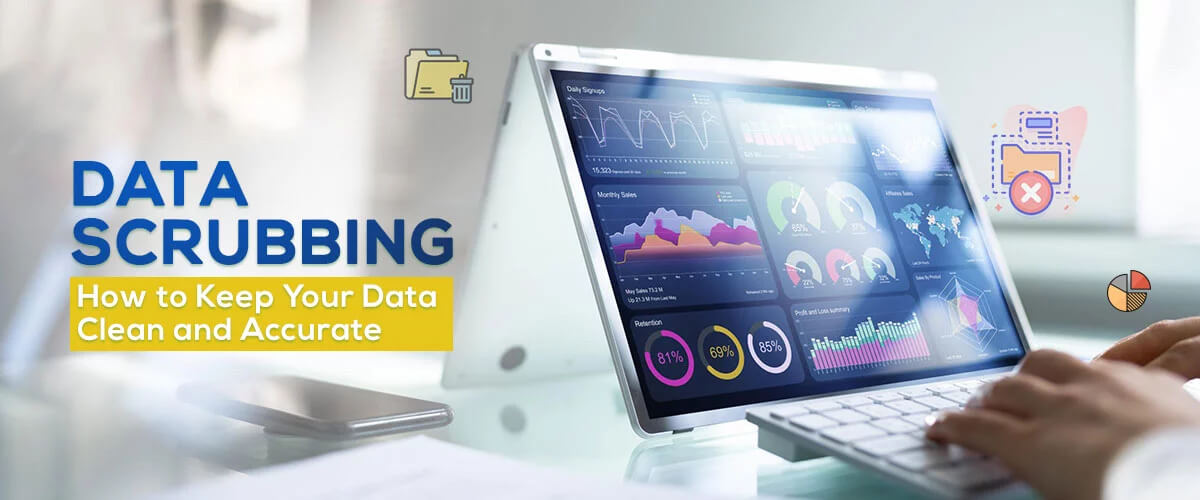Are you having trouble keeping your data clean and correct? Do you know what data scrubbing is and how it can help you?
With the rise of big data, it has never been more critical to make sure your information is as perfect and up-to-date as possible. As with anything in life, there will always be some degree of error when dealing digitally with information, but you can minimize the number of inaccuracies in your data sets with careful data scrubbing practices. If you check there will be a small percentage of incorrect or missing information in most data sets. It is unrealistic to expect 100% accuracy, but you can get pretty close with data scrubbing!

In this post, we will explore:
- What is Data Scrubbing?
- The Importance of Data Scrubbing
- Data Scrubbing vs. Data Cleansing
- Methods for Using Data Cleaning in Your Business
- Who Should Use Data Scrubbing?
- What Are the Best Data Cleansing Tools?
- Would You Like to Outsource Data Management?
- Conclusion
Let’s get started!
What is Data Scrubbing?
Data scrubbing is also known as data cleansing is the process of removing duplicate, incorrect and incomplete data from the database. It is often used to cleanse data before it is used for analysis or reporting. Finally, the objective is to cleanse your data of the frequent flaws that hinder its use and drive-up expenses. The following are some of the most common information problems that are resolved throughout the data cleaning process:
- Duplicate information elimination: The process of removing duplicate records from a database.
- Inconsistent information: This refers to inconsistent data or incorrect values within the set. This can be caused by human error, software issues, or other factors.
- Missing information: The process of locating and incorporating missing data into a database.
- Common errors and typos: This refers to fixing incorrect values commonly resulting from human error.
These are just a few examples of the data scrubbing process. As you can see, it is an essential step in ensuring that your information is maintained.
The Importance of Data Scrubbing
Nowadays, businesses are dealing with more data than ever before, and having it be inaccurate is a significant problem. It will ensure that your information is relevant, reliable, and ready to use. A well-maintained information bank will help you make informed business decisions, keep your customers happy, and protect your brand.
Data Scrubbing vs. Data Cleansing
It is important to note that data cleansing is the same process as data scrubbing.
Data cleaning, also known as data cleansing, is essential in any data-driven process. It can be done by correcting or deleting obsolete, redundant, corrupt files that are inconsistent with one another, as well as tidying up your information, so it’s easy to manage for future use.
It is the process of utilizing actual tools to do a much deeper clean than just having someone check over database spread sheets and making corrections.
Data cleansing and scrubbing can be used interchangeably to refer to the same process. They both end up with your information being cleaned up to have ready-to-use information for long-term storage within the business.
Methods for Using Data Cleaning in Your Business
You now know what data cleansing is and why it’s so important. You may be wondering how you can start the process! But don’t worry, because there is no “one size fits all” when doing this task. Here are some general pointers that could help get things started:
Follow the tips mentioned above, and you’ll be on your way to having accurate data that will help your business thrive.
Who Should Use Data Scrubbing?
There’s no debate about the importance of clean information; it’s a no-brainer. However, specific industries must make scrubbing their highest priority because they play essential roles in society.
Data scrubbing is a top priority in data-intensive businesses such as banking/finance, insurance, retail, and telecommunications.
What Are the Best Data Scrubbing Tools?
Here are some of the best data scrubbing tools that can help with your business
- OpenRefine
- Winpure
- Cloudingo
- TIBCO Clarity
- Trifacta Wrangler
Would You Like to Outsource Data Management?
If you are short on time or resources to manage your data scrubbing process, you may want to consider outsourcing data cleansing services.
Outsourcing data management can save you a lot of time and money while allowing you to focus on core business tasks.
Conclusion
You now have learned the importance of data scrubbing and some ways to get started. Make sure to implement a information quality strategy to maintain the accuracy and reliability of your information.
If you need help with this or have any questions, feel free to contact us at PGBS! We’re here to help.
